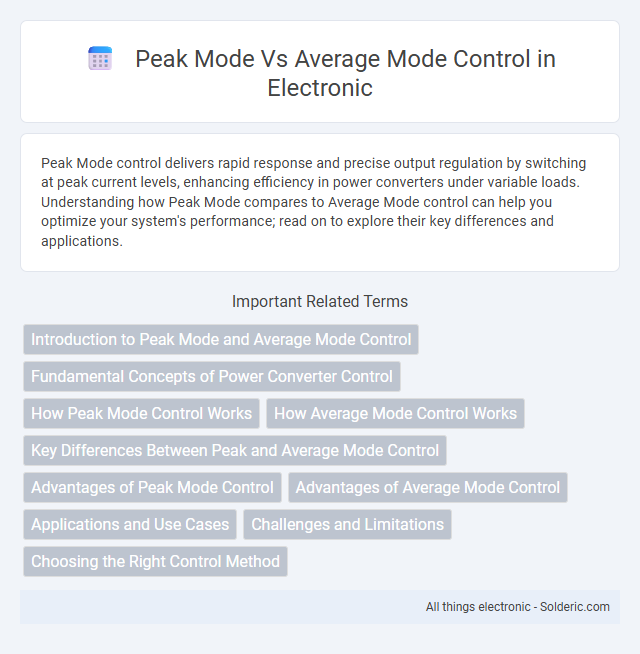Peak Mode control delivers rapid response and precise output regulation by switching at peak current levels, enhancing efficiency in power converters under variable loads. Understanding how Peak Mode compares to Average Mode control can help you optimize your system's performance; read on to explore their key differences and applications.
Comparison Table
| Feature | Peak Mode Control | Average Mode Control |
|---|---|---|
| Operational Principle | Switching based on peak current limit | Switching based on average current control |
| Current Ripple | Higher current ripple | Lower current ripple |
| Control Loop Type | Non-linear, direct peak detection | Linear, continuous current feedback |
| Stability | Less stable under varying loads | More stable, better transient response |
| Complexity | Simpler implementation | More complex circuitry required |
| Power Efficiency | Lower efficiency at light loads | Higher efficiency across load range |
| EMI Emissions | Higher due to abrupt switching | Lower due to smoother operation |
| Applications | Simple DC-DC converters, cost-sensitive designs | High-performance power supplies, noise-sensitive applications |
Introduction to Peak Mode and Average Mode Control
Peak Mode Control regulates the duty cycle by comparing the inductor current to a reference peak current, ensuring fast transient response and stable operation in switching power supplies. Average Mode Control maintains continuous monitoring of the average inductor current over each switching cycle, optimizing efficiency and reducing output voltage ripple. Both control methods play critical roles in power converter design, influencing system dynamics, noise performance, and loop stability.
Fundamental Concepts of Power Converter Control
Peak Mode control in power converters regulates the switch based on the instantaneous current reaching a set threshold, ensuring fast transient response and inherent current limiting. Average Mode control instead regulates the average inductor current over a switching cycle, providing more stable output voltage and improved noise immunity. Your choice between peak and average current mode control impacts converter efficiency, stability, and transient performance in various applications.
How Peak Mode Control Works
Peak Mode Control operates by continuously monitoring the inductor current and switching off the power transistor as soon as the current reaches a predetermined peak value, preventing overcurrent conditions and improving system stability. This method enhances transient response by maintaining a constant peak current, which directly controls the output voltage during load changes. Peak Mode Control is widely used in DC-DC converters for its simplicity and fast reaction to load variations, optimizing efficiency and thermal management.
How Average Mode Control Works
Average Mode Control regulates output voltage by continuously monitoring the average current flowing through the inductor, comparing it to a reference value. This method ensures stable and precise current regulation by adjusting the duty cycle of the switching element in real time. Your power supply system benefits from reduced ripple and improved transient response with this control technique.
Key Differences Between Peak and Average Mode Control
Peak mode control regulates the inductor current by comparing it to a peak reference, providing fast transient response and inherent overcurrent protection. Average mode control, on the other hand, maintains the inductor current at an average value over each switching cycle, offering better steady-state accuracy and reduced current ripple. Understanding these key differences helps you choose the optimal control method for applications requiring precise current regulation or robust response to load changes.
Advantages of Peak Mode Control
Peak Mode Control offers faster transient response and improved system stability by immediately reacting to load changes, reducing output voltage ripple and enhancing overall power supply efficiency. It enables better noise immunity and more accurate current regulation compared to Average Mode Control, which results in superior performance in high-speed and high-frequency applications. Your power management design benefits from Peak Mode by achieving optimal dynamic response and robust control during rapid load variations.
Advantages of Average Mode Control
Average Mode Control offers superior stability and simplifies frequency compensation by regulating the average inductor current, reducing output voltage ripple and improving overall efficiency in power converters. Its continuous control approach enhances transient response and minimizes stress on components compared to Peak Mode Control. Choosing Average Mode Control allows you to achieve precise current regulation, particularly beneficial in applications requiring tight output voltage tolerances.
Applications and Use Cases
Peak mode control excels in high-performance switching power supplies, where fast transient response and precise current limiting are critical, such as in aerospace and telecommunications equipment. Average mode control is preferred in applications requiring improved efficiency and reduced electromagnetic interference (EMI), including LED drivers and battery chargers. Both control modes address specific operational needs by optimizing current regulation to enhance stability and performance in their respective use cases.
Challenges and Limitations
Peak Mode Control faces challenges such as increased switching frequency causing higher electromagnetic interference (EMI) and potentially greater power losses. Average Mode Control may suffer from slower transient response and complexity in implementation due to the need for accurate current sensing and control algorithms. Both modes have limitations balancing efficiency, response time, and stability in power electronics applications.
Choosing the Right Control Method
Selecting the appropriate control method between Peak Mode and Average Mode Control depends on application-specific requirements such as response speed, efficiency, and electromagnetic interference (EMI) sensitivity. Peak Mode Control offers faster transient response and simpler implementation, ideal for low-power or cost-sensitive designs. Average Mode Control provides improved efficiency and reduced output ripple, making it suitable for high-performance systems demanding stable voltage regulation and lower noise.
Peak Mode vs Average Mode Control Infographic

 solderic.com
solderic.com